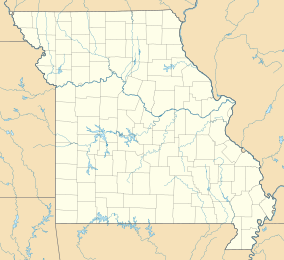Locust Creek Covered Bridge State Historic Site facts for kids
Quick facts for kids Locust Creek Covered BridgeState Historic Site |
|
|---|---|
 |
|
| Location | Linn County, Missouri, United States |
| Nearest city | Meadville |
| Area | 32.22 acres (13.04 ha) |
| Established | 1968 |
| Operator | Missouri Department of Natural Resources |
| Website | Locust Creek Covered Bridge State Historic Site |
|
Locust Creek Covered Bridge
|
|
| Nearest city | Meadville, Missouri |
| Area | 9.9 acres (4.0 ha) |
| Built | 1868 |
| Built by | Bishop & Eaton |
| NRHP reference No. | 70000340 |
| Added to NRHP | May 19, 1970 |
The Locust Creek Covered Bridge State Historic Site is a special place in Linn County, Missouri. It is a historic site that is open to the public. The Missouri Department of Natural Resources takes care of it.
This famous covered bridge is sometimes called the Linn County Bridge. You can find it about 3 miles (4.8 km) east of Meadville, Missouri. It is 151 feet (46 m) long and 16 ft 8 in (5.08 m) wide. This makes it the longest of only four covered bridges left in Missouri! In 1970, it was added to the National Register of Historic Places. This means it is a very important historical landmark.
The Bridge's Story
Building the Bridge
The Locust Creek Covered Bridge was built a long time ago, in 1868. The leaders of Linn County hired a company called Bishop & Eaton to build it. They paid about 5,500 dollars for the bridge.
The bridge uses a special design called a Howe truss. This design uses strong wooden beams made of white pine. It also has vertical iron rods that hold the diagonal wooden parts tightly together. This makes the bridge very strong.
Life of the Bridge
When it was first built, the bridge was used by wagons, horses, and people walking. It was a busy spot for locals. People would even carve their names and messages on the inside walls of the bridge.
The bridge was also a popular place for fishing and swimming. A famous person named John J. Pershing visited the bridge. His childhood home and a state park named after him are nearby.
In the early 1900s, cars started using the bridge as part of Missouri Route 8. But in 1930, a new road, U.S. Route 36, was built. This new road went around the bridge, so cars no longer needed to cross it. The bridge also runs next to the Hannibal and St. Joseph Railroad tracks.
Protecting the Bridge
After World War II, the path of Locust Creek changed. The bridge ended up spanning a dry creek bed. Over time, the creek bed filled with mud. This meant the bridge was often resting on soft ground.
In 1968, the State of Missouri bought the bridge. They created the Locust Creek Covered Bridge State Historic Site to protect it. Workers repaired the bridge, putting on a new roof, sides, and floor.
In 1991, another big improvement was made. The bridge was raised by six feet! This helped protect the wooden parts from the wet, marshy ground below. Thanks to these efforts, this historic bridge is still standing today for everyone to enjoy.




